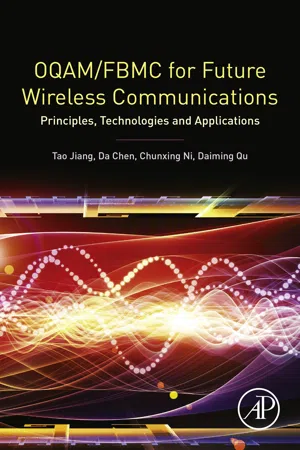
OQAM/FBMC for Future Wireless Communications
Principles, Technologies and Applications
- 268 pages
- English
- ePUB (mobile friendly)
- Available on iOS & Android
OQAM/FBMC for Future Wireless Communications
Principles, Technologies and Applications
About this book
OQAM/FBMC for Future Wireless Communications: Principles, Technologies and Applications introduces the concepts and key technologies of OQAM/FBMC, which has been regarded as the potential physical layer technique in future wireless communication systems. It comprises 10 chapters that provide an overview of wireless communications, introduce wireless channels, single carrier and multicarrier modulations, and three types of FBMC systems, also comparing OQAM/FBMC with OFDM. Other chapters introduce the OQAM/FBMC communication system model, the FFT implementation, CP insertion, PSD analysis, prototype filter optimization, joint PAPR reduction and sidelobe suppression, overhead reduction with virtual symbols, time and frequency domain channel estimations, block-wise SFBC for MIMO OQAM/FBMC, and much more.- Provides a comprehensive guide to most major OQAM/FBMC techniques- Includes a detailed comparison between OFDM and OQAM/FBMC- Provides readers with a complete introduction to OQAM/FBMC, from the transmitter to the receiver- Gives readers an up-to-date view of future mobile communications and how QAM/FBMC supports them
Frequently asked questions
- Essential is ideal for learners and professionals who enjoy exploring a wide range of subjects. Access the Essential Library with 800,000+ trusted titles and best-sellers across business, personal growth, and the humanities. Includes unlimited reading time and Standard Read Aloud voice.
- Complete: Perfect for advanced learners and researchers needing full, unrestricted access. Unlock 1.4M+ books across hundreds of subjects, including academic and specialized titles. The Complete Plan also includes advanced features like Premium Read Aloud and Research Assistant.
Please note we cannot support devices running on iOS 13 and Android 7 or earlier. Learn more about using the app.
Information
Introduction
Abstract
Keywords
1.1 An Overview of Wireless Communications
Table of contents
- Cover image
- Title page
- Table of Contents
- Copyright
- Chapter 1: Introduction
- Chapter 2: Fundamentals of OQAM/FBMC
- Chapter 3: Power Spectral Density of OQAM/FBMC
- Chapter 4: Prototype Filter
- Chapter 5: Peak-to-Average Power Ratio
- Chapter 6: Overhead Reduction
- Chapter 7: Synchronization
- Chapter 8: Channel Estimation
- Chapter 9: MIMO OQAM/ FBMC
- Chapter 10: Applications
- Index